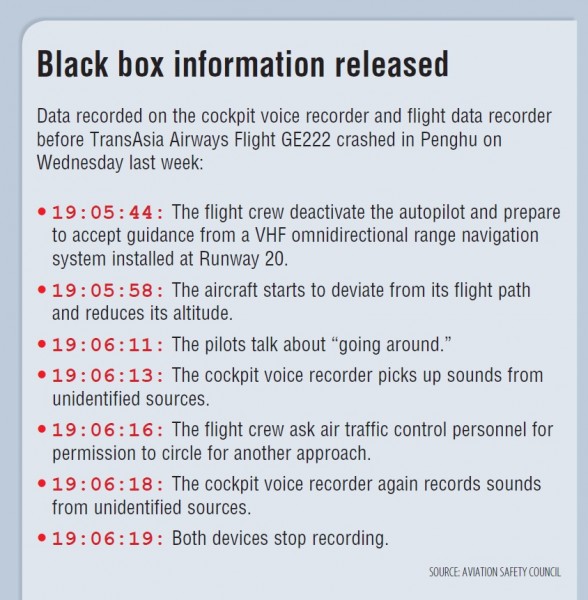《TAIPEI TIMES 焦點》Black boxes show plane deviated from its path

Aviation Safety Council executive director Thomas Wang yesterday talks about the results of the council’s preliminary investigation into the TransAsia Airways Flight GE222 crash near Magong Airport in Penghu on Wednesday last week. Photo: Liao Chen-hui, Taipei Times
PRELIMINARY: Many questions remain, such as why the plane strayed from its path and whether the engine decelerated because of mechanical failure or other reasons
By Shelley Shan / Staff reporter
TransAsia Airways (復興航空) Flight GE222 had deviated from its flight path before crashing near Magong Airport in Penghu on Wednesday last week, the Aviation Safety Council (ASC) said yesterday, adding that it crashed eight seconds after the pilots considered “going around” for another approach.
The council presented the results of its preliminary investigation yesterday after listening to the plane’s cockpit voice recorder (CVR) and flight data recorder (FDR).
Council executive director Thomas Wang (王興中) said the wreckage of the aircraft was found in the forest and some houses outside Magong Airport.
Wang said the flight crew had deactivated the autopilot system about two minutes after it was given permission at 7:03pm to land on Runway 20.
However, the aircraft started deviating from its flight path and dropped altitude. The flight crew then talked about the possibility of going around, according to the black box recordings, Wang said.
While Magong Airport requires landing aircraft to approach the runway at 201 degrees, the recordings showed that the plane had shifted to 188 degrees, Wang said.
Investigators found that the speed of the left engine (Engine No. 1) had decelerated at 7:06:13, only two seconds after the two pilots talked about going around.
At the same time, the CVR recorded sounds from unidentified sources, which investigators said could be noises made when the plane flew into the forest. When the investigators found the engine at the crash site, they discovered that the engine’s intake valve was filled with tree branches.
According to the engine’s manufacturer, Pratt & Whitney Canada, the tree branches could have hindered the engine’s ability to generate power, Wang said.
To complete the going around, an aircraft must accelerate.
The CVR also showed that the pilots asked the air traffic personnel’s permission to go around, which was again followed by recordings of indistinguishable sounds.
In terms of weather conditions, Wang said the FDR showed that the wind speed did not change much — varying between 40 and 50 nautical miles (74 to 93km) when the aircraft tried to approach the runway.
Wang said the pilots talked about the weather conditions twice. The first time was before they talked about switching from Runway 20 to Runway 02. The second time was when they asked to land at Runway 20 again, in which they noted that “the wind was very strong.”
“The pilots did not express verbally that there was an emergency situation,” Wang said.
Wang added that the investigators did not hear from the CVR the pilots saying “No way,” as some media reports had said.
Conversations transcribed from the black boxes also showed that the pilots requested to switch from Runway 20 to Runway 02 twice after they were informed that visibility at the airport was only 800m.
However, they requested to land on Runway 20 after they were told that visibility had improved to 1,600m and another ATR aircraft owned by Uni Air (立榮航空) had secured permission to land on Runway 20.
According to the Civil Aeronautics Administration, there was a strong southwesterly wind blowing on Penghu that day because of Typhoon Matmo. As aircraft need to land or take off against the wind’s direction, all the planes arriving in Penghu that day were to land on Runway 20.
Magong Airport’s Runway 02 is equipped with an instrument landing system, which requires a minimum visibility of 800m. However, aircraft landing on Runway 20 need to follow the guidance of an VHR omnidirectional range (VOR) navigation system, which requires a visibilility of 1,600m.
The council’s report still left many questions unanswered, such as whether the engine decelerated because of engine failure or because of the tree branches that were sucked into the engine.
Investigators also need to determine why the plane deviated from its course, as the VOR was found to be functioning normally at the time, and why the plane changed altitude drastically after the pilots talked about going around.
Wang said the council is scheduled to submit a preliminary report of the investigation to the Executive Yuan and International Civil Aviation Organization before the end of this month.
新聞來源:TAIPEI TIMES




















